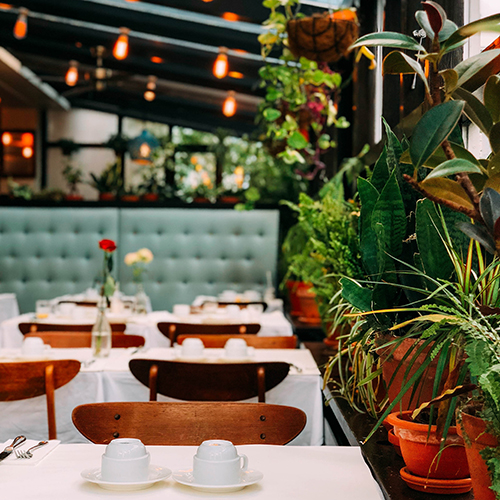Ways Your Restaurant Can Go Green This Year
Customers are growing increasingly concerned with eco-friendliness, which makes it imperative for restaurants to make a change. Not only is going green appealing to your customers, but it can also help your business cut down on food costs and save on utilities. While going green in your business may seem like a monumental task, there are many quick and easy changes that your restaurant can make to reduce its environmental impact.
What Does it Mean to Go Green?
Going green means pursuing environmentally friendly practices that help your business reduce its impact on the Earth. In the foodservice industry, this can be through reducing energy usage, cutting down on the use of disposable products, minimizing food waste, or many other practices.
7 Ways Your Restaurant Can Go Green
There are many quick and easy ways that your business can reduce its impact on the Earth and ensure that its natural resources will last for future generations. So, whether your restaurant's goal for the New Year is to be eco-conscious or you want to reduce waste for Earth Day, here are seven ways that your restaurant can go green.
1. Reduce Your Water Usage
From dishwashing stations to bathrooms, just about every aspect of a foodservice establishment requires water. But, sources of fresh water are quickly depleting, making it important that restaurants do their best to conserve water. One of the best ways that you can reduce your water usage is to use low flow spray valves, which allow you to use less water when washing dishes. Another option would be to outfit all of your restrooms with water-saving toilets and urinals, which use less water per flush. Additionally, many restaurants give every customer a glass of water when they sit down. You can reduce your water usage by only serving customers water if they ask for it.

2. Invest in Energy-Efficient Appliances
The foodservice industry uses a lot of electricity, mostly through the use of appliances. One of the best ways to cut down on your restaurant's energy usage is to switch from standard appliances and equipment to energy-efficient models, such as Energy Star Qualified appliances. Additionally, there are many small changes you can make to reduce energy consumption:
- Use energy-efficient light bulbs, such as LED, halogen, and CFL bulbs.
- Install motion sensor lights in your bathrooms instead of keeping the lights on throughout the day.
- Use spot air conditioners to cool your space rather than running the building's air conditioning.
- Clean the condenser coils on your refrigeration equipment. Dust accumulating on your refrigeration equipment causes it to work harder and waste electricity.
3. Restructure Your Food Shipments
Getting regular or weekly food shipments delivered to your restaurant results in a higher carbon footprint, because the delivery truck has to drive to your establishment more frequently. There are two excellent ways that you can ensure that you always have fresh food on hand while reducing your establishment's impact: buying local produce and ordering food in bulk.
Buy Local Produce
One of the best ways to reduce your establishment's carbon footprint is to buy food from local sources. If your food comes from nearby farms, it has a shorter distance to travel, so it spends less time on a truck. Additionally, if you're serving your customers local food, you can market your business as a farm-to-table business and offer your menu items at a premium. Another option, if you have a lot of outdoor space, is to grow your own food and offer your customers hyper-local foods.
Order Food in Bulk Shipments
If you're in a city or don't have easy access to fresh and local foods, another option would be to restructure your food orders so you get food less frequently but in bulk quantities. And because you would be receiving orders less regularly, you'd be reducing your environmental impact. When re-structuring your food orders, consider what foods you need to use first and which items you can store in your freezer to prolong their shelf life.
4. Use Eco-Friendly Disposables

Fortunately, there are many great eco-friendly alternatives to traditional plastic disposables. For example, instead of plastic utensils and dinnerware, you can use compostable options that are made out of renewable materials such as sugarcane, bamboo, or PLA plastic. Many restaurant owners are wary of eco-friendly disposables because they perceive them as being flimsy and low quality, but many new types of eco-friendly options are just as durable as their plastic counterparts. When choosing eco-friendly alternatives, look for disposables that are labeled “No PFAS Added” to protect your customers from potentially harmful chemicals.
Additionally, many cities are now considering banning plastic straws, so it's an excellent time for your business to make the switch to eco-friendly alternatives. PLA plastic and paper straws are two great substitutes for traditional plastic straws. Some cities have also banned the use of plastic bags, so you should consider switching to eco-friendly bags as well.
5. Minimize Food Waste
If your portions are too large, customers can end up throwing away large amounts of food. Additionally, if you don't carefully manage your inventory, your food may expire before you use it, resulting in food waste. To prevent food waste, you can implement the First In, First Out (FIFO) method, conduct a food waste audit, or use portion control tools. There are also some creative ways that you can use food scraps and overripe foods and prevent food waste. For example, you can use vegetable scraps to create a delicious homemade vegetable broth. Additionally, many overripe fruits have the perfect sweetness and texture for baked goods.

6. Optimize Your Front-of-House
Air conditioning in the summer and heating in the winter can increase your restaurant's electricity consumption significantly. There are other ways that the products you use in your front-of-house affect the environment. For example, if you use cloth napkins and tablecloths, you'll need to increase your water consumption to wash them each night. Here are some tips you can use to make your restaurant's dining space eco-friendly:
- Install thick, insulated windows so your establishment retains temperature well. These insulated windows will keep hot air in during the winter and cool air in during the summer, so you won't need to use the air conditioning or heating as often.
- Buy furniture that's made of renewable materials like reclaimed wood or bamboo.
- Use metal utensils and melamine or china dinnerware rather than disposable options.
- Get rid of your tablecloths, so you don't have to clean them each night. Additionally, uncovered tables are popular now due to their rustic look and feel.
7. Choose Eco-Friendly Cleaning Products
Keeping your restaurant clean is important, but many types of cleaning chemicals have harsh agents that can wreak havoc on the environment. Instead, opt for environmentally friendly chemicals which have the same cleaning power but without the harsh elements. Additionally, you can try steam cleaning your floors and carpets rather than using chemicals.
What Does it Mean to Be a Zero Waste Restaurant?
A zero-waste restaurant means that a restaurant does not produce any trash or food waste that must be taken to a landfill. Although the total number of zero-waste restaurants around the world is few, many businesses and restaurants are adapting to these eco-friendly practices in order to minimize their carbon footprint on the world and embrace a zero-waste ethos.
Going green in your restaurant can be a challenge, but doing your part to use eco-friendly products and eco-conscious practices reduces your impact on the environment and helps you reduce food costs and utility bills. Fortunately, there are many quick and easy ways that your restaurant can go green, such as switching to eco-friendly disposables or installing energy-efficient appliances and light bulbs.



